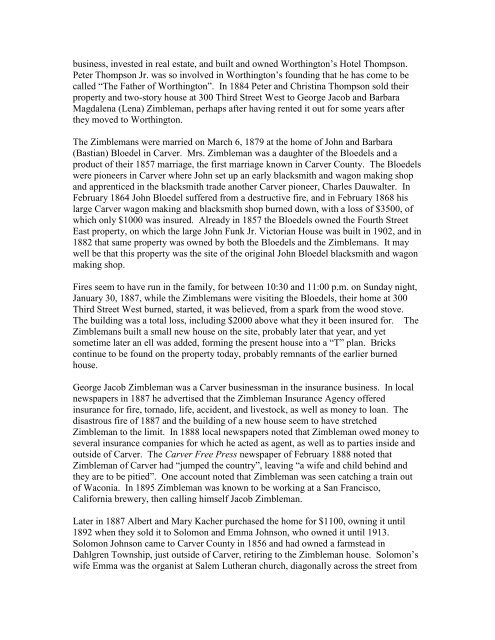Historic Homes and Businesses in Carver - Carver County Historical ...
Historic Homes and Businesses in Carver - Carver County Historical ...
Historic Homes and Businesses in Carver - Carver County Historical ...
You also want an ePaper? Increase the reach of your titles
YUMPU automatically turns print PDFs into web optimized ePapers that Google loves.
us<strong>in</strong>ess, <strong>in</strong>vested <strong>in</strong> real estate, <strong>and</strong> built <strong>and</strong> owned Worth<strong>in</strong>gton‟s Hotel Thompson.<br />
Peter Thompson Jr. was so <strong>in</strong>volved <strong>in</strong> Worth<strong>in</strong>gton‟s found<strong>in</strong>g that he has come to be<br />
called “The Father of Worth<strong>in</strong>gton”. In 1884 Peter <strong>and</strong> Christ<strong>in</strong>a Thompson sold their<br />
property <strong>and</strong> two-story house at 300 Third Street West to George Jacob <strong>and</strong> Barbara<br />
Magdalena (Lena) Zimbleman, perhaps after hav<strong>in</strong>g rented it out for some years after<br />
they moved to Worth<strong>in</strong>gton.<br />
The Zimblemans were married on March 6, 1879 at the home of John <strong>and</strong> Barbara<br />
(Bastian) Bloedel <strong>in</strong> <strong>Carver</strong>. Mrs. Zimbleman was a daughter of the Bloedels <strong>and</strong> a<br />
product of their 1857 marriage, the first marriage known <strong>in</strong> <strong>Carver</strong> <strong>County</strong>. The Bloedels<br />
were pioneers <strong>in</strong> <strong>Carver</strong> where John set up an early blacksmith <strong>and</strong> wagon mak<strong>in</strong>g shop<br />
<strong>and</strong> apprenticed <strong>in</strong> the blacksmith trade another <strong>Carver</strong> pioneer, Charles Dauwalter. In<br />
February 1864 John Bloedel suffered from a destructive fire, <strong>and</strong> <strong>in</strong> February 1868 his<br />
large <strong>Carver</strong> wagon mak<strong>in</strong>g <strong>and</strong> blacksmith shop burned down, with a loss of $3500, of<br />
which only $1000 was <strong>in</strong>sured. Already <strong>in</strong> 1857 the Bloedels owned the Fourth Street<br />
East property, on which the large John Funk Jr. Victorian House was built <strong>in</strong> 1902, <strong>and</strong> <strong>in</strong><br />
1882 that same property was owned by both the Bloedels <strong>and</strong> the Zimblemans. It may<br />
well be that this property was the site of the orig<strong>in</strong>al John Bloedel blacksmith <strong>and</strong> wagon<br />
mak<strong>in</strong>g shop.<br />
Fires seem to have run <strong>in</strong> the family, for between 10:30 <strong>and</strong> 11:00 p.m. on Sunday night,<br />
January 30, 1887, while the Zimblemans were visit<strong>in</strong>g the Bloedels, their home at 300<br />
Third Street West burned, started, it was believed, from a spark from the wood stove.<br />
The build<strong>in</strong>g was a total loss, <strong>in</strong>clud<strong>in</strong>g $2000 above what they it been <strong>in</strong>sured for. The<br />
Zimblemans built a small new house on the site, probably later that year, <strong>and</strong> yet<br />
sometime later an ell was added, form<strong>in</strong>g the present house <strong>in</strong>to a “T” plan. Bricks<br />
cont<strong>in</strong>ue to be found on the property today, probably remnants of the earlier burned<br />
house.<br />
George Jacob Zimbleman was a <strong>Carver</strong> bus<strong>in</strong>essman <strong>in</strong> the <strong>in</strong>surance bus<strong>in</strong>ess. In local<br />
newspapers <strong>in</strong> 1887 he advertised that the Zimbleman Insurance Agency offered<br />
<strong>in</strong>surance for fire, tornado, life, accident, <strong>and</strong> livestock, as well as money to loan. The<br />
disastrous fire of 1887 <strong>and</strong> the build<strong>in</strong>g of a new house seem to have stretched<br />
Zimbleman to the limit. In 1888 local newspapers noted that Zimbleman owed money to<br />
several <strong>in</strong>surance companies for which he acted as agent, as well as to parties <strong>in</strong>side <strong>and</strong><br />
outside of <strong>Carver</strong>. The <strong>Carver</strong> Free Press newspaper of February 1888 noted that<br />
Zimbleman of <strong>Carver</strong> had “jumped the country”, leav<strong>in</strong>g “a wife <strong>and</strong> child beh<strong>in</strong>d <strong>and</strong><br />
they are to be pitied”. One account noted that Zimbleman was seen catch<strong>in</strong>g a tra<strong>in</strong> out<br />
of Waconia. In 1895 Zimbleman was known to be work<strong>in</strong>g at a San Francisco,<br />
California brewery, then call<strong>in</strong>g himself Jacob Zimbleman.<br />
Later <strong>in</strong> 1887 Albert <strong>and</strong> Mary Kacher purchased the home for $1100, own<strong>in</strong>g it until<br />
1892 when they sold it to Solomon <strong>and</strong> Emma Johnson, who owned it until 1913.<br />
Solomon Johnson came to <strong>Carver</strong> <strong>County</strong> <strong>in</strong> 1856 <strong>and</strong> had owned a farmstead <strong>in</strong><br />
Dahlgren Township, just outside of <strong>Carver</strong>, retir<strong>in</strong>g to the Zimbleman house. Solomon‟s<br />
wife Emma was the organist at Salem Lutheran church, diagonally across the street from


